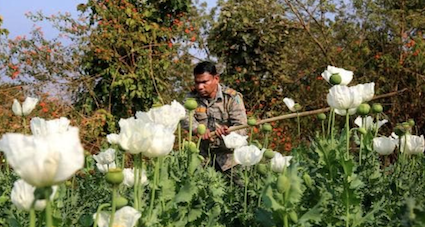With poppy and cannabis (ganja) plants gradually emerging as a major cash crop in the Maoist dominant areas of Bihar, Jharkhand, Odisha, and Chhattisgarh, the Central Reserve Police Force (CRPF) have been exploring alternatives for identifying these plants through live images transmitted by drones and satellites.
CRPF officers informed that farmers in those areas have started growing poppy or cannabis plants along with paddy or wheat in the same farmland, which makes it extremely difficult for them to identify them thus they are taking help from scientists of the Indian Council for Agricultural Research (ICAR) and agriculture departments of these states.
Officials in the Bihar police headquarters claim as earnings from narcotics remain an important source of funding, Maoist sympathizers have been motivating, and often even forcing poor farmers of the Maoist-infested Gaya, Jamui, and Nawada districts near the Jharkhand border, which can’t be accessed through motor-able roads, to grow opium and cannabis.
Retired bureaucrat Vinod Kumar Sharma, who had been keeping a vigilant eye on Maoists over decades, said the demonetisation drive broke the financial backbone of the rebels who later employed various methods to keep their organisation afloat and the opium idea was one of them thus they have been desperately luring poor farmers to grow cannabis and poppy.
“As per our information, the Maoists pay about Rs 2,000 per bigha (3.9 bighas make one hectare) to a farmer for the yield of poppy and Rs 1,000 per bigha for cannabis.”
Jamui SP Pramod Kumar Mandal said two separate FIRs have been lodged against the landowners. “The sowing of poppy crops begins in November while the harvesting takes place mid-March. The crops are generally grown on fields located beside rivers and in deep forests in order to avoid detection,” he added.
“Locate crops using drones and satellite images by separate teams of central reserve police force (CRPF), Sashastra Seema Bal (SSB), narcotics control bureau (NCB) and destroy them right before they get ready for harvesting,” he said, suggesting a way to tackle the menace.
An Inspector General of the CRPF’s Chhattisgarh sector also added while CRPF has already placed orders for high-tech drones with very specialized cameras, apart from detection, their next priority is to destroy those crops. He said that the forces have to think hard about entering the fields because there could be an ambush waiting for them.
Responding to the issue of destruction, Bihar CRPF DIG, stated that besides identifying crops, drones will also be used to detect the human movement on the ground very minutely and so that they can know of ambushes.
According to estimates of NCB, the two crops are grown on more than 2,000 acres in these three districts which yield more than Rs 1,000 crore a year.
The money thus gained is spent on procurement of weapons and maintenance of the People’s Liberation Guerrilla Army, the armed wing of the CPI (Maoist).
A narcotic control bureau official also informed that they had chalked out a three-pronged strategy to curb the opium menace. “We are also trying to identify farmers growing opium on their private land with the help of GPS and register cases against them.
Providing details about their strategy, zonal director of Narcotics Control Bureau, Kumar Manish informed that the cases will also be registered against the farmers growing the banned narcotics on the forest land.
Apart from that, the Bihar government has offered livelihood alternative to
farmers who have been surreptitiously cultivating opium to make a fast buck.
“Under the alternative livelihood opportunity, we have suggested them to grow lemongrass or do honey bee farming which fetch attractive money. We have also tagged them with buyers who will visit the place to buy the oil extracted from lemongrass,” the divisional forest officer Abhishek Kumar added.
(This article is largely borrowed from the Swarajyamag).


